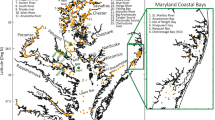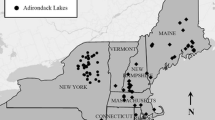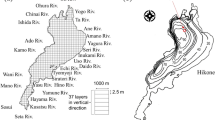Abstract
To analyze the correlations of summer anoxia/hypoxia in the Chesapeake Bay with watershed input and wind conditions, statistics were applied to nearly three decades of monitoring data. The results of Pearson correlation coefficients, multivariate regression analysis, and cluster analysis indicate that anoxia/hypoxia has a strong positive correlation with nutrient load and a moderate negative correlation with wind speed. Physical relationships among the relevant constituents were analyzed. Nutrient loads and the subsequent decay of organic matter are the primary factors that control the oxygen demand causing summer anoxia and hypoxia, while episodic wind can partially erode stratification and reduce anoxia/hypoxia. Although the extent of anoxia/hypoxia reduction differs with wind direction, higher wind speeds result in more destratification and anoxia/hypoxia reduction than lower wind speeds and are more important than the effect of wind direction. The influences of freshwater discharge, stratification, and temperature were also analyzed. Computer modeling results were used to obtain dissolved oxygen conditions at finer temporal and spatial scales to supplement the scattered and discrete observations from monitoring stations and for better understanding of anoxia/hypoxia development under episodic wind events.








Similar content being viewed by others
References
Bahner, L. 2001. The Chesapeake Bay and tidal tributary volumetric interpolator, software VOL3D version 4.0. NOAA Chesapeake Bay Office, Annapolis, MD,
Browner, W.S., and T.B. Newman. 1987. Are all significant P values created equal? The analogy between diagnostic tests and clinical research. Journal of the American Medicine Association 257: 2459–2463.
CEC. 2000. Chesapeake Bay Agreement, 2000 Amendments. Annapolis, MD, USA: Chesapeake Executive Council.
Cerco, C.F., S.C. Kim, and M. Noel. 2010. The 2010 Chesapeake Bay Eutrophication Model. US Army ERDC, Vicksburg, MS: A report to USEPA Chesapeake Bay Program.
Chen, S.N., and L.P. Sanford. 2009. Axial wind effects on stratification and longitudinal salt transport in an idealized, partially mixed estuary. Journal of Physical Oceanography 39(8): 1905–1920.
Cohn, T.A., D.L. Caulder, E.J. Gilroy, L.D. Zynjuk, and R.M. Summers. 1992. The validity of simple statistical method for estimating fluvial constituent loads: an empirical study involving nutrient loads entering Chesapeake Bay. Water Resources Research 28(9): 2353–2363.
Conley, D.J., J. Carstensen, R. Vaquer-Sunyer, and C.M. Duarte. 2009. Ecosystem thresholds with hypoxia. Hydrobiologia 629: 21–29.
DiMarco, S.F., P. Chapman, N. Walker, and R.E. Hetland. 2010. Does local topography control hypoxia on the eastern Texas–Louisiana shelf? Journal of Marine Systems 80(1–2): 25–35.
Hagy, J.D., W.R. Boynton, C.W. Keefe, and K.V. Wood. 2004. Hypoxia in Chesapeake Bay, 1950–2001: long-term changes in relation to nutrient loading and river flow. Estuaries 27: 634–658.
Harding, L.W., M. Leffler, and G.B. Mackiernan. 1992. Dissolved oxygen in the Chesapeake Bay: a scientific consensus. College Park, Maryland: Maryland Sea Grant. 18 pp.
IAN UMCES. 2010. Chesapeake Bay 2010 summer ecological forecast, Ecocheck Newsletter, Integration Analysis Network, University of Maryland Center for Environmental Science. (http://ian.umces.edu/ecocheck/forecast/chesapeake-bay/2010/indicators/anoxia/#_Data)
Jasinski, D. A. 2003. Is the Chesapeake getting worse? It’s not as bad as some report, Chesapeake Bay Journal, November 2003. http://www.eco-check.org/pdfs/masc_newsletter_5.pdf
Jasinski, D., G. Shenk, E. Parry, W. Dennison, B. Longstaff, and M. Williams. 2005. Summer 2005 ecological forecast technical documentation. Chesapeake Bay Program, Annapolis, MD, USA, July. 10 pp, 2005.
Jordan, T.E., D.L. Correll, J. Mikias, and D.E. Weller. 1991. Long-term trends in estuarine nutrients and chlorophyll, and short-term effect of variation in watershed discharge. Marine Ecology Progress Series 75: 121–132.
Kato, H., and O.M. Phillips. 1969. On the penetration of a turbulent layer into a stratified fluid. Journal of Fluid Mechanics 37: 643–655.
Kemp, W. M., W. R. Boynton and other 16 authors. 2005. Eutrophication of Chesapeake Bay: historical trends and ecological interactions. Marine Ecology Progress Series 303: 1–29.
Knauss, J. A. 1997. Introduction to Physical Oceanography, 2nd or later editions. Prentice-Hall, upper Saddle River, NJ, 309 pp
Koroncai, R., L.C. Linker, J. Sweeny, and R. Batiuk. 2003. Setting and allocating the Chesapeake Bay basin nutrient and sediment loads: USEPA Chesapeake Bay Program Office. MD: Annapolis.
Lee, Y.J., W.R. Boynton, M. Li, and Y. Li. 2013. Role of late winter-spring wind influencing summer hypoxia. Estuaries and Coasts 36: 683–696.
Li, Y., and M. Li. 2011. Effects of winds on stratification and circulation in a partially mixed estuary. Journal of Geophysical Research V116, C12012.
Malone, T.C., W.M. Kemp, H.W. Ducklow, W.R. Boynton, J.H. Tuttle, and R.B. Jonas. 1986. Lateral variation in the production and fate of phytoplankton in a partially stratified estuary. Marine Ecology Progress Series 32(2–3): 149–160.
MASC.2006. Chesapeake Bay 2006 summer ecological forecast, Newsletter by the Chesapeake Bay Program’s Monitoring and Analysis Subcommittee (MASC). (http://www.eco-check.org/pdfs/masc_newsletter_5.pdf).
MDDNR. 2012. The 2012 Chesapeake Bay summer Dead Zone, Maryland Department of Natural Resources. (http://mddnr.chesapeakebay.net/eyesonthebay/stories/DeadZoneStatus_Summer2012_090512.pdf).
Murphy, R.R., W.M. Kemp, and W.P. Ball. 2011. Long-term trends in Chesapeake Bay seasonal hypoxia, stratification, and nutrient loading. Estuaries and Coasts 34: 1293–1309.
O’Donnell, J., H.G. Dam, W.F. Bohlen, W. Fitzgerald, P.S. Gay, A.E. Houk, D.C. Cohen, and M.M. Howard-Strobel. 2008. Intermittent ventilation in the hypoxic zone of western Long Island Sound during the summer of 2004. Journal of Geophysical Research V113, C09025.
Officer, C.B., R.B. Biggs, J.L. Taft, L.E. Cronin, M.A. Tyler, and W.R. Boynton. 1984. Chesapeake Bay anoxia: origin, development and significance. Science 233: 22–27.
Pritchard, D.W. 1967. Observations of circulation in coastal plain estuaries. In Estuaries, AS Publ. 83, ed. G.H. Lauff, 37–44. Sci, Washington DC: Am Acad.
Scully, M.E. 2010a. Wind modulation of dissolved oxygen in Chesapeake Bay. Estuaries and Coasts 33: 1164–1175.
Scully, M.E. 2010b. The importance of climate variability to wind driven modulation of hypoxia in Chesapeake Bay. Journal of Physical Oceanography 40: 1435–1440.
Scully, M.E., C. Friedrichs, and J. Brubaker. 2005. Control of estuarine stratification and mixing by wind-induced straining of the estuarine density field. Estuaries 28(3): 321–326.
Shenk, G.W. and L.C. Linker, 2013. Development and application of the 2010 Chesapeake TMDL watershed model. Journal of the American Water Resources Association (JAWRA) 1–21. doi: 10.1111/jawr.12105
Taylor, R. 1990. Interpretation of the correlation coefficient: a basic review. JDMS 1: 35–39.
Testa, J.M., and W.M. Kemp. 2012. Hypoxia-induced shifts in nitrogen and phosphorus cycling in Chesapeake Bay. Limnology and Oceanography 57: 835–850.
USEPA. 2010. Chesapeake Bay total maximum daily load for nitrogen, phosphorus and sediment. Annapolis MD: U.S. Environmental Protection Agency Chesapeake Bay Program Office.
Wang, P., and L. Linker. 2008. Improvement of regression simulation in fluvial sediment loads. J. Hydraul. Engr. 134(10): 1527–1531.
Wang, P., L. Linker, D. Jasinski, W. Dennison, G. Shenk, and R. Batiuk. 2006. Forecast of summer anoxia for the Chesapeake Bay, Estuarine and Coastal Modeling: Proc. Ninth International Conference, Charleston, SC, USA, Oct 31-Nov 2, 2005.., p767-695.
Wang, P., H. Wang, and L. Linker. 2013a. Assessment of hypoxia and its relationship with nutrient loads and wind, and implication to the Chesapeake Bay management, Proc. 8 th International Symposium on Environment, May 13–16, 2013, Athens, Greece.
Wang, P., L. Linker, and R. Batiuk. 2013b. Monitored and modeled correlations of sediment and nutrients with Chesapeake Bay water clarity. Journal of the American Water Research Association 49: 1103–1118.
Wang. P., and H. Wang. 2012. The wind effect on Chesapeake Bay destratification and hypoxia. July 2012 Modeling Subcommittee Quarterly Meeting, Annapolis, MD, http://www.chesapeakebay.net/S=0/calendar/event/18508/quarterly_-_ping.pdf
Wilson, R.E., R.L. Swanson, and H.A. Crowley. 2008. Perspectives on long-term variations in hypoxic conditions in western Long Island Sound. Journal of Geophysical Research 113: C12011.
Acknowledgments
We would like to thank Drs. Dave Forrest from VIMS and Peter Tango of USGS, and two anonymous reviewers for their insightful comments and input.
Author information
Authors and Affiliations
Corresponding author
Additional information
Communicated by Dennis Swaney
Rights and permissions
About this article
Cite this article
Wang, P., Wang, H. & Linker, L. Relative Importance of Nutrient Load and Wind on Regulating Interannual Summer Hypoxia in the Chesapeake Bay. Estuaries and Coasts 38, 1048–1061 (2015). https://doi.org/10.1007/s12237-014-9867-5
Received:
Revised:
Accepted:
Published:
Issue Date:
DOI: https://doi.org/10.1007/s12237-014-9867-5




